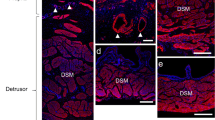Abstract
The aim of this study was to give a microscopic description of the organization, the innervation and the slow or fast type of the striated fibers of the external urethral sphincter in the female rat. Conventional methods for photonic microscopy and immunochemistry were applied to cross and longitudinal sections of snap-frozen urethra. With hematoxylin-eosin stained cross sections, striated fibers are of small diameter and attached directly to the surrounding connective tissue. They are innervated by cholinergic endplates as shown by acetylcholinesterase techniques and alpha-bungarotoxin binding. The histological aspects of the cross sections as well as the distribution of endplates along the length of the sphincter suggest an organization of the fibers in four bundles, possibly acting as a photographic diaphragm does. Like striated skeletal muscle fibers, the fibers bind monoclonal antibodies against dystrophin with subsarcolemmal distribution and against desmin which visualizes striations. All the fibers express fast myosin heavy chains and very few co-express slow myosin heavy chains as determined by immunocytochemistry. We are taking advantage of the diaphragmatic organization of the striated sphincter to develop a longitudinal section as a model of chronic incontinence to test the efficiency of grafted myoblasts provided by fast striated skeletal muscle.





Similar content being viewed by others
References
Burnett AL, Wesselmann U (1999) History of the neurobiology of the pelvis. Urology 53:1082–1089
Byers TJ, Kunkel LM, WatkinsC (1991) The subcellular distribution of dystrophin in mouse skeletal, cardiac, and smooth muscle. J Cell Biol 115:411–421
Chiappinelli VA (1985) Actions of snake venom toxins on neuronal nicotinic receptors and other neuronal receptors. Pharmacol Ther 31:1–32
Colleselli K, Stenzl A, Eder R, Strasser H, Poisel S, Bartsch G (1998) The female urethral sphincter: a morphological and topographical study. J Urol 160:49–54
Dubovitz V (1985) Muscle biopsy: a practical approach, 2nd edn. Baillière Tindall, London
Elbadawy A (1996) Functional anatomy of the organs of micturition. Urol Clin North Am 23:177–210
Gosling JA (1985) The structure of the female lower urinary tract and pelvic floor. Urol Clin North Am 12:207–214
Gosling JA, Dixon JS, Critchley HO, Thompson SA (1981) A comparative study of the human external sphincter and periurethral levator ani muscles. Br J Urol 53:35–41
Ibraghimov-Beskrovnaya O, Ervasti JM, Leveille CJ, Slaughter CA, Sernett SW, Campbell KP (1992) Primary structure of dystrophin-associated glycoproteins linking dystrophin to the extracellular matrix. Nature 355:696–702
Junemann KP, Schmidt RA, Melchior H, Tanagho EA (1987) Neuroanatomy and clinical significance of the external urethral sphincter. Urol Int 42:132–136
Koëlle GB, Friedenwald JS (1949) A histochemical method for localizing cholinesterase activity. Proc Soc Exp Biol Med 70:617–622
Kokoua A, Homsy Y, Lavigne JF, Williot P, Corcos J, Laberge I, Michaud J (1993) Maturation of the external urinary sphincter: a comparative histotopographic study in humans. J Urol 150:617–622
Ludwikowski B, Oesch Hayward I, Brenner E, Fritsh H (2001) The development of the external sphincter in humans. BJU Int 87:565–568
Myers RP (1991) Male urethral sphincteric anatomy and radical prostatectomy. Urol Clin North Am 18:211–227
Myers RP (2001) Practical surgical anatomy for radical prostatectomy. Urol Clin North Am 28:473–490
Narayan P, Konety B, Aslam K, Aboseif S, Blumenfeld W, Tanagho E (1995) Neuroanatomy of the external urethral sphincter: implications for urinary continence preservation during radical prostate surgery. J Urol 153:337–341
Oelrich TM (1983) The striated urogenital sphincter muscle in the female. Anat Rec 205:223–232
Pestronk A, Drachman DB (1978) A new stain for quantitative measurement of sprouting at neuromuscular junctions. Muscle Nerve 1:70–74
Pette D, Staron RS (1990) Cellular and molecular diversities of mammalian skeletal muscle fibers. Rev Physiol Biochem Pharmacol 116:1–76
Phillips JI, Davies I (1980) The comparative morphology of the bladder and urethra in young and old female C57BL/Icrfat mice. Exp Gerontol 15:551–562
Russell B, Baumann M, Heidkamp MC, Svanborg A (1996) Morphometry of the aging female rat urethra. Int Urogynecol J Pelvic Floor Dysfunct 7:30–36
Schroder HD, Reske-Nielsen E (1983) Fiber types in the striated urethral and anal sphincters. Acta Neuropathol (Berl) 60:278–282
Snooks SJ, Swash M (1984) Perineal nerve and transcutaneous spinal stimulation: new methods for investigation of the urethral striated sphincter musculature. Br J Urol 56:406–409
Snooks SJ, Setchell M, Swash M, Henry MM (1984) Injury to innervation of pelvic floor sphincter musculature in childbirth. Lancet 8402:546–550
Thind P (1995) The significance of smooth and striated muscles in the sphincter function of the urethra in healthy women. Neurourol Urodyn 14:585–618
Tichy M (1989) The morphogenesis of human sphincter urethrae muscle. Anat Embryol 180:577–582
Tokunaka S, Murakami U, Ohashi K, Okamura K, Yachiku S (1984) Electrophoretic and ultrastructural analysis of the rabbit's striated external urethral sphincter. J Urol 132:1040–1043
Tokunaka S, Murakami U, Okamura K, Miyata M, Yachiku S (1986) The fiber type of the rabbits' striated external urethral sphincter: electrophoretic analysis of myosin. J Urol 135:427–430
Tokunaka S, Okamura K, Fujii H, Yachiku S (1990) The proportions of fiber types in human external urethral sphincter: electrophoretic analysis of myosin. Urol Res 18:341–344
Von Hayek H (1960) Das Faserkaliber in den MM. transversus perinei und sphincter urethrae. Z Anat Entwicklungsgesch 121:455–458
Wilson D (1809) A description of two muscles surrounding the membranous part of the urethra. Med Chirurg Soc Lond 1:175–180
Yiou R, Delmas V, Carmeliet P, Gherardi RK, Barlovatz-Meimon G, Chopin D, Abbou CC, Lefaucheur JP (2001) The physiopathology of pelvic floor disorders: evidence from a histomorphologic study of the perineum and a mouse model of rectoprolapse. J Anat 199:599–607
Yoshiyama M, DeGroat WC, Fraser MO (2000) Influences of external urethral sphincter relaxation induced by alpha-bungarotoxin, a neuromuscular junction blocking agent, on voiding dysfunction in the rat with spinal cord injury. Urology 55:956–960
Acknowledgements
This study was supported by the Fondation de l'Avenir (grants ETO-0 and ETO-1 for AS). CP was granted by the Association Française contre les myopathies. The authors thank Nicolle Delphinefor technical assistance.
Author information
Authors and Affiliations
Corresponding author
Rights and permissions
About this article
Cite this article
Praud, C., Sebe, P., Mondet, F. et al. The striated urethral sphincter in female rats. Anat Embryol 207, 169–175 (2003). https://doi.org/10.1007/s00429-003-0340-7
Accepted:
Published:
Issue Date:
DOI: https://doi.org/10.1007/s00429-003-0340-7




